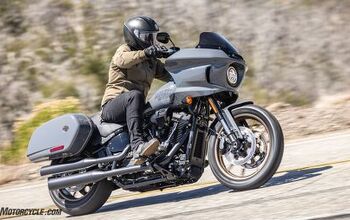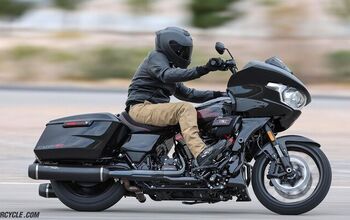2018 Harley-Davidson Low Rider Review - First Ride

Same profile, different heart
I’ll go ahead and start with this: I’ve never been a fan of the Low Rider. Clearly that puts me at odds with tons of Harley-Davidson buyers. The Low Rider has been popular with both customizers and riders who prefer a more compact riding position (read shorter). I am neither. With this in mind, I’ll dive into what my time with the 2018 Harley-Davidson Low Rider was like.
2018 Harley-Davidson Low Rider
| Engine | 16.0/20 |
| Suspension/Handling | 10.5/15 |
| Transmission/Clutch | 7.5/10 |
| Brakes | 8.0/10 |
| Instruments/Controls | 4.0/5 |
| Ergonomics/Comfort | 7.0/10 |
| Appearance/Quality | 9.5/10 |
| Desirability | 8.0/10 |
| Value | 8.0/10 |
| Overall Score | 78.5/100 |
Harley-Davidson Introduces All New 2018 Softail Line
As with all of the other former Dynas, the Low Rider is now a member of the Softail line. If you haven’t noticed the howling and gnashing of teeth over this change in some quarters of the Harley market, you haven’t been paying attention. So, take a moment to bring yourself up to speed with my overview of the 2018 Softail line. This review will assume you’ve already read that article, and you’ll have a better understanding of the points raised here if you’re familiar with the information.
When first looking at the 2018 Low Rider, those familiar with the model will find it instantly recognizable. The profile is the same, the headlight has its signature brow, the stepped seat remains. However, there are also some fairly obvious changes. The dual shocks have vanished for the single underseat unit. The prominent battery box is also missing from the right side and now lives behind one of the side covers below the seat. While the dual instruments are still mounted on the tank, the 2018’s housing is more pronounced. The two-into-one exhaust was replaced with a set of duallies. And the engine isn’t a Twin Cam but rather a Milwaukee-Eight!
Those are the visible differences. The invisible ones are largely related to the chassis. First, H-D says the redesigned Softail frame is 65% stiffer compared to last year. In the real world, if the stiffness is calculated from contact patch to contact patch, the increase is a functional 35% – after passing the forces through the steering head and the swingarm pivot. Second, the Low Rider’s cornering clearance has increased while keeping the rider triangle essentially unchanged. This is a notable functional improvement in the motorcycle. Although the Low Rider, thanks to its mid-mount pegs, doesn’t gain as much lean angle as some other Softails, the difference is real – and noticeable when ridden back-to-back with the previous generation.
Harley clearly wanted to highlight this improvement in the Low Rider (and the entire Softail line) since almost the entire route of the two day introduction traversed some of the best sport riding pavement in Southern California. No, I’m not saying that the Low Rider is a sportbike, but I am saying that Low Rider owners no longer need to be leery of corners. When hard parts do touch down, the Low Rider drags pegs first giving warning before solidly mounted components begin to grind. The improvements in the chassis go beyond ground clearance, though. The increased chassis stiffness erased the chassis flex most commonly encountered in highway-speed sweepers. Quick left-right transitions are also flex-free. Steering is more responsive than one might expect from a 19-inch front wheel, making mid-corner corrections a minimal-effort affair.
The suspension was changed along with the chassis, and the additional travel – increased to 3.6-inches – takes care of most road irregularities. The dual bending valves in the fork do an admirable job of soaking up bumps, and the solo rear shock’s hydraulic preload adjuster means that riders can easily adapt the Low Rider to varying rider/passenger/cargo loads. While magazine types, like myself, will still be asking for more suspension, Low Rider owners will simply be benefiting from the 2018’s improvements.
Although the change to the chassis was responsible for the shock and awe surrounding the Softail line, the Milwaukee-Eight engine steals the show. To make the engine’s solid mounting to the frame tolerable to riders, a second counterbalancer was included. So, when you’re running from 0–60mph 10% faster (as Harley claims), your mitts won’t feel like they’re attached to a paint shaker. Quite the contrary, the M-E stays comfortably vibration-free through most of the range typically used. Yes, some vibration enters the fray above 3,500 rpm, but realistically, how much time do you spend there? Mostly quick passing maneuvers or the occasional sporty attack of a series of corners. Other than that, the 107 cu. in. engine is in its happy place riding the fat 110 lb-ft (claimed) of the torque curve.
As with all the Milwaukee-Eights I’ve ridden, the EFI-tuning is spot on, delivering smooth throttle transitions no matter how many times I tried to trip it up by rolling it off/on in corners. Shifting is solid and low-effort. The torque-assist clutch is appreciated, but this is a Big Twin. So, expect to use some muscles on the lever.
The rider accommodations of the Low Rider have always been tight. That, along with the 27.2-inch seat height, has made it popular with shorter-inseamed riders. If anything, the 2018’s rider triangle feels slightly tighter in the handlebar, but that could be easily remedied by rotating it a smidge in its clamp. Still, it’s the cramped position of my legs that has always turned me off to the Low Rider. Look at the photos, my knees are close to being higher than my hips. I know this is a failing on my part, though. One of the other journalists on the press ride is taller, with longer legs than me, and he said the Low Rider was his favorite of the Softails. So, either he’s crazy, or I’m just a pampered moto-journalist who expects to be coddled.
For 2018, Harley-Davidson threw us a curve-ball – in a good way. The Low Rider has all of the characteristics that has made it popular since the 1970s. Additionally, it benefits from improved handling and a more powerful, smoother engine. All you have to give up are the dual shocks of the old Dyna model. This seems like a fair trade, since the new suspension has more travel and works better. But, hey, that’s just me.
The 2018 Harley-Davidson Low Rider is available in Vivid Black for $14,999. Wicked Red, Electric Blue, and Bonneville Salt Pearl will set you back $15,399.
2018 Harley-Davidson Low Rider
+ Highs
- More power with less vibration
- More cornering clearance
- The same Low Rider style fans love
– Sighs
- Cramped riding position for larger riders
- Less cornering clearance than some of the Softails
- Some riders seem really attached to their dual shocks
2018 Harley-Davidson Low Rider | |
|---|---|
| MSRP | $14,999, $15,399 (color option) |
| Engine Type | Milwaukee-Eight® 107 45° V-Twin |
| Bore and Stroke | 100 mm x 114.3 mm |
| Fuel System | Electronic Sequential Port Fuel Injection (ESPFI) |
| Compression Ratio | 10.0:1 |
| Valve Train | 4 valves per cylinder, pushrods |
| Transmission | 6-Speed Cruise Drive |
| Final Drive | Belt |
| Front Suspension | Conventional fork |
| Rear Suspension | Mono-shock, hydraulic preload adjuster |
| Front Brake | Dual 4-piston calpers, floating discs |
| Rear Brake | 2-piston caliper, floating disc |
| Front Tire | 110/90B19,62H,BW |
| Rear Tire | 180/70B16,77H,BW |
| Rake/Trail | 30° / 6.4 in. |
| Wheelbase | 64.2 in. |
| Seat Height | 27.2 in. |
| Curb Weight | 661 lb. (claimed) |
| Fuel Capacity | 5 gal. |
| Available Colors | Vivid Black, Wicked Red, Electric Blue, Bonneville Salt Pearl |

Like most of the best happenings in his life, Evans stumbled into his motojournalism career. While on his way to a planned life in academia, he applied for a job at a motorcycle magazine, thinking he’d get the opportunity to write some freelance articles. Instead, he was offered a full-time job in which he discovered he could actually get paid to ride other people’s motorcycles – and he’s never looked back. Over the 25 years he’s been in the motorcycle industry, Evans has written two books, 101 Sportbike Performance Projects and How to Modify Your Metric Cruiser, and has ridden just about every production motorcycle manufactured. Evans has a deep love of motorcycles and believes they are a force for good in the world.
More by Evans Brasfield









































Comments
Join the conversation
Look at the seat. It's way thick. An aftermarket seat from C & C Seats could easily replace rider's butt backward by 2". Maybe more.
mmm .... This (HD Low Rider) or the Motto Guzzi Eldorado ? Test rode both of them ... Each has its pluses and minuses ... Both are beautiful Motorcycles (IMO) ... Sigh ...
I currently own a 2016 Motto Guzzi V7 Stone and a 2015 HD Super Low 1200T